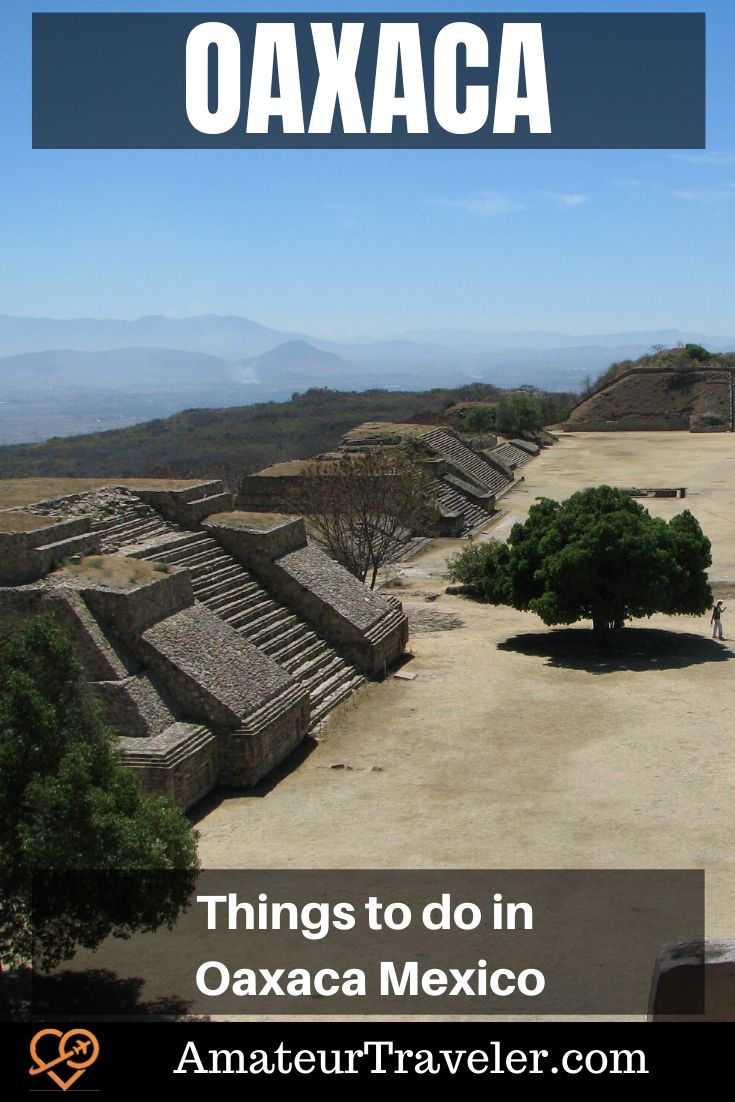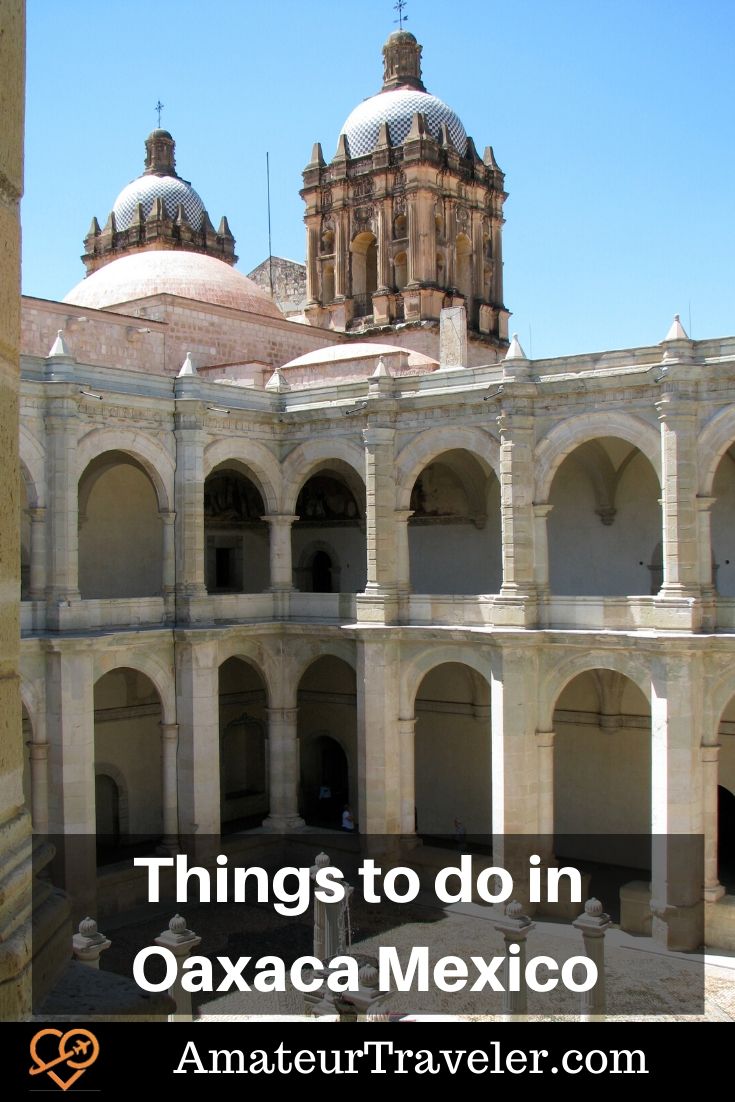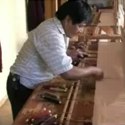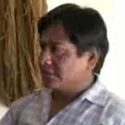Things to do in Oaxaca Mexico
categories: mexico travelOaxaca (pronounced wu-ha-ka) is a center for pre-Columbian history in southern Mexico and is also well-known for its food. It gets a lot of tourists but still manages to retain its charm. Let’s get it out of the way now that one of the things to do in Oaxaca is eat and I will cover that.

Table of contents: ()

Oaxaca History
It is useful to know just a little history of Oaxaca before we get into what to see and what to eat. The area was home to the Zapotec civilization starting 2,500 years ago. Still today, the first language in about 60% of the local homes is not Spanish but an indigenous language. Some of the most significant sites in Oaxaca like Mount Alban are Zapotec sites. Also, much of the city’s unique culinary culture traces back to these Pre-Columbian roots as well.
Things to do in Central Oaxaca
The Zocalo and the Cathedral
I would start your visit of Oaxaca with a visit to the Zocalo. Life in Oaxaca centers around the Zocalo or central square which is adjacent to the side of the local cathedral. The Zocalo has a good crowd of people milling about by 10 am in the morning and will have crowds and music into the evening. There are sidewalk cafes on two of the sides, street vendors, shoeshine stands, and a gazebo in the center of the square.
If you are hungry, try a snack from one of the street vendors like a cup of corn (with butter, salt, and picante sauce).
As with any city in Mexico, a visit to the cathedral is nearly mandatory but the cathedral is not the most spectacular church in Oaxaca.
Church of Santo Domingo de Guzmán
The honor of the most spectacular church in Oaxaca goes to the church of Santo Domingo which is 5 blocks north of the cathedral.
This complex was originally built as a monastery by the Dominicans starting in 1575. It later served as a barracks for soldiers and a museum. Portions of the large complex are now part of a local university but it is the church that I would direct you to visit.
This church interior is built in the Baroque style and is gilded extensively. When it was restored in the 1900s 60,000 sheets of 23.5-karat gold leaf were used in the interior.
There is a museum connected to the church in the old abbey. It has displays of artifacts from the area from the Zapatec civilization through more recent history. None of the displays are in English but an audio guide is available for $5. The entry fee is 51 pesos. This museum is not extensive, but the building itself was interesting. The museum is open Tuesday to Sunday from 10 am to 6 pm.
Monte Albán
One of the signature sites of Oaxaca is Monte Albán. More than 2,000 years ago the Zapotec people leveled the top of this mountain to build their city in the clouds. It was the first planned city in the Americas and dominated the region through trade from 500 B.C. to 700 A.D. Apparently, most of the nearby hills are covered with ruins like this. Our tour guide said that they suspect only 10% of the ruins in the area have been excavated.
The Zapotec did all this with stone tools and a lot of work. Their nickname was the “cloud people” because of their city’s location. The Zapotec were traders and the men would travel far and wide trading so the city was run in large part by the women.
Somehow there were enough men around that even though it was a monogamous society the women averaged 16 children. Our guide said the same thing still happens in Mexico when the man who has been working in the U.S. for two years is told by his wife that she is pregnant. “Remember that really good conversation we had on the internet recently? That’s when I got pregnant.” That is why he told us he prefers to stay in Mexico. He was wearing a San Francisco Giants hat so he was clearly very intelligent.
He told us that the people lived to around 45. Skin cancer and osteoporosis were apparently two of their biggest health issues. They looked more Chinese than Mexican and the rich people deformed the forehead of their children with rubber bands to make a clear delineation between the classes. The diet was mostly corn, beans, squash, and chiles. The rich got to consume chocolate and vanilla as well. A slave cost 200 cocoa beans.
Their astronomy was the second most advanced in the new world with the Mayans taking first place in the astronomy science fair.
The Big Tree
Also outside of town is a spot that a lot of the tours will stop at which is the Big Tree in Santa Maria del Tule. The tree is nearly 138 feet around although it is not a tall tree. It is on a tentative list of UNESCO World Heritage Sites. I would not go out of my way to see it but it is on the way to Mitla.
San Pablo Villa de Mitla
Mitla is another Zapotec site that is 25 miles from Oaxaca. Mitla is a much smaller site than Monte Alban and much of the site was reused by the Spanish to build the church of San Pablo in Mitla on top of a former Zapotec religious site. The best part of the ruins is the intricate stonework. The saddest part was that some of the painted stucco work had been marred by graffiti.
The village of San Pablo Villa de Mitla is known for its textiles and mezcal.
Museums
Museo Rufino Tamayo
The Museo Rufino Tamayo had a good collection of pre-Columbian art although not a particularly large collection. The museum can be seen in about 15-30 minutes.
Museo Rufino Tamayo
For prehispanic art, the Museo Rufino Tamayo has a great reputation although I did not get there. It’s on Morelos between Tinoco y Palacios and Porfirio Diaz.
MUFI (Museo de Filatelia de Oaxaca)
The MUFI is a stamp museum that is a free museum with a lovely courtyard and gardens as well. You can find it adjacent to the Church of Santo Domingo de Guzmán.
Ethno-botanical garden
Locals recommend the Ethno-botanical gardens at the Church of Santo Domingo de Guzmán. They have English tours three times a week.
Neighborhoods
Barrio Jalatlaco is one of the two oldest neighborhoods in the city and is about a 10-minute walk from the city center. It is a colorful neighborhood filled with coffee shops. It is less crowded than the center of town.
The Markets
The markets around Oaxacastart opening up around 10 am. There is some great smelling food in the markets, flowers, clothes, spices, and many other things. We will come back to the markets when we talk about places to eat, but they are a great place to pick up local spices or Oaxaca specialty items like mezcal or roasted crickets.
Mercado de Abastos
This market is reputed to be the largest indigenous market in the Americas. It is just huge. It is to the southwest of the center of town just over the railroad tracks. I am not sure there is anything you could not find at the market. They had clothes, cutlery, fruit, small food stalls, pots, and pans and you could even see a dentist or get a gynecological exam. Parts of it are a dark warren and I noticed only two other tourists there unlike the rest of town. This is where the locals shop.
Mercado Benito Juarez
This market is a great place to pick up local specialties like molé, cheese, chiles, or for the more brave, roasted crickets. You can also find leather goods and mezcal.
Mercado 20 Novembre
Another great local market and one of my favorite places to eat in Oaxaca, see below. This market is mostly small local restaurants. It is cheap and the food is good.
Tlacalula Market
The village of Tlacalula is on the road to Mitla. They have a large Sunday market at Tlacalula which is one of the largest markets in the area. In addition to the usual collection of food and produce, it also has furniture and some wonderful crafts. I bought two necklaces and a bracelet for my wife and daughter for about 5 dollars in total. I did not really bargain, because why worry too much about saving a couple of pesos when the prices are already great.
Local Crafts
I ran into a local 3rd generation weaver named Filipe Hernandez while people-watching in the zocalo one night. We struck up a conversation and he invited me to come out and see his weaving production. Filipe’s family speaks Zapotec at home so his family may have been in this valley for something like 2500 years.
Filipe is a 4th generation weaver with two large looms in his home. His daughter-in-law and granddaughter crushed small dried bugs called cochineal from prickly pear cactus used to make the traditional red dye. They carded and spun their own wool, washed it, and then dyed it with natural dyes such as the cochineal for red, alfalfa for green, bark of the cedar tree and pomegranate skin for tans, marigold for rust, walnut shells for brown, black beans for black, prickly pear fruit for purple and indigo for blue. Filipe showed me how rugs are created on the loom and how the patterns he used echoed the patterns his ancestors had carved in stone at Mitla.
What to Eat in Oaxaca
While I was in Oaxaca I met with Sarah who was the guest on Travel to Oaxaca, Mexico – Amateur Traveler Episode 174 for “coffee”. I had a famous Oaxaca hot chocolate instead which I recommend. Back in the Zapatec heyday, chocolate was only for the upper crust. Be glad you don’t live then.
Dinner in the Zocalo
When I was last there even the restaurants on the side of the square had reasonable prices. While there were certainly less expensive places to eat, they provide good food and a great chance to watch the city go by. Each night I was in Oaxaca there was a different band in the gazebo in the Zocalo.
La Grand Torta
One lunch spot that I quite enjoyed was the restaurant La Grand Torta. A torta is a sandwich and I am a bit of a connoisseur of the sandwich. I had a Torta Cubana which was a very good sandwich with ham, egg, cheese, beans, avocado, mushrooms, and tomato. After that, it was time for a siesta in the heat of the day.
Los Pacos
Los Pacos is a great place to try a sampler of the local molé. I was able to order lunch with 6 of the 7 types of molés. Colorado and negro were probably my favorites but I liked them all. I did not catch all the names but I had from left to right and top to bottom amarillo, colorado, something, verde, something, and negro.
Mercado 20 Novembre
The best meal that I had in Oaxaca was not in a fancy tourist restaurant nor was it eaten for that matter with any other tourists in sight. Like many cities in Mexico, some of the most interesting culinary experiences can be found in the markets where the locals eat. In particular one of the entrances to the Mercado 20 Novembre is a dim smoke-filled corridor filled with the wonderful smell of grilled beef or Carne Asada.
I have eaten Carne Asada numerous times in Tijuana on volunteer trips. Usually, carne asada is the meal served to celebrate the hard work we have done. So my mouth immediately started salivating. I looked around for where I could sit down and order but there the adventure begins.
In my limited Spanish, I questioned one of the vendors there until I found out that ordering the meal I wanted was not a simple task.
- Buy chiles and onions – The woman closest to the interior of the market will sell you onions (cebollas) and chiles to grill. She will also give you a plate that you will need to collect the rest of the ingredients on this scavenger hunt.
- Buy your meat – At the entrance to the market, there are a number of butchers with their meat displayed. Carne Asada is made with flank steak. You will order your meat from the butcher who also has a grill and will grill it up for you. Sausage is also a popular meat in the market. The butcher will also take the onions and chiles you brought and grill them directly on the coals.
- Buy your tortillas – While you are waiting for your meat to be grilled a tortilla vendor will arrive and sell you the tortillas.
- Buy your beverage – Oh you want something to drink? A vendor in between the butcher and the tables can sell you a soda or a beer (cervesa).
- Buy your side dishes – When you have your meat, onions, and peppers cooked you will return to the vendor who sold you the onions and chiles. This is the only area that has tables. Now you can purchase sides like guacamole and pico de gayo (diced onions and tomatoes) and have a seat.
It’s just that easy. You only have to collect your meal from 4 different vendors in 5 different steps, but it is worth the effort. This is a good meal to share with a friend as most of the sides are larger than one person would need. Yes, my meal is missing the grilled onions. I figured out the system a little too late, but now you will be prepared.
Merced Market
Former guest on Amateur Traveler Sarah Menkedick recommended the Merced Market as a place to eat. “Walking north from the Zocalo (towards the mountains) take a right on Murguia and follow it East all the way until you see the entrance to a market on your left. It’ll be right before you hit the periphery road. They have a great little courtyard there with the best chilaquiles in town. Inside the market are awesome empanadas, quesadillas, etc. A bit of a walk but worth it.”
“Sanchez Pascuas is another good market – walk up the hill on Porfirio Diaz and you’ll see the entrance on your left, marked by a big Laurel tree.”
La Catrina de Alcala
Probably the fanciest place where I ate in Oaxaca was La Catrina de Alcala which is a lovely boutique hotel. I had a wonderful blue cheese soup there.
Crickets and “Tuna”
Two strange things on the menu in Oaxaca are Crickets and Tuna. I scratched my head when I saw “Tuna” listed as a flavor of ice cream. But it turns out that tuna is the word for cactus fruit.
Crickets, on the other hand, are just that. They are a traditional pre-Columbian dish. I shared a plate of crickets in the zocalo with a backpacker I met in the city. They are served with lots of spices and guacamole. They were a bit too spicy for him and a bit too insecty for me.
Where to Stay in Oaxaca
There are a number of charming and inexpensive boutique hotels in the city as well as a number of Airbnb apartments that you can rent. There are a few hostels in town as well for the particularly budget-minded.
Oaxaca Map to Points of Interest
Getting to Oaxaca
Oaxaca has good connections via air (airport code: OAX) which is how I arrived. I made connections in Mexico City from the United States. It is 5 and 1/2 hours from Mexico City by car (with toll roads). The first-class bus from Mexico City to Oaxaca will take 6 to 7 hours but the ride itself should be pleasant.
From Oaxaca airport, I took a collective (shared) taxi to my hostel. A taxi collectivo was about 40 pesos which is one third the cost of a private taxi. You can arrange a taxi from the counter in the airport near the baggage claim. Last I checked Uber was still not available in Oaxaca.
A collective taxi is not only cheaper but more entertaining. I struck up a conversation with an interesting Indian couple from Detroit who taught me a bit about Indian history and cuisine. After they were dropped off I talked with an older American couple who were coming back for their 10th trip to Oaxaca. As I was the last person in the cab I switched to Spanish and asked the cab driver about the guitar he had in the front seat. He had only been playing for 4 months and was not in a group yet. That led to talking about me playing guitar for a church, what church I went to and the cab driver singing me a lovely song from the Catholic church.
Conclusion
I should have known from that cab ride into town how friendly the locals would be. If I ever disappear from the map, there is a good chance you will find me in Oaxaca. I will be eating the “tuna” ice cream, but probably still turning down the crickets.

+Chris Christensen | @chris2x | facebook
Leave a Reply
Tags: article, oaxaca, video travel podcast























 Oaxaca, Mexico – Felipe the Weaver (part 1) – Video Episode 46
Oaxaca, Mexico – Felipe the Weaver (part 1) – Video Episode 46 Oaxaca, Mexico – Felipe the Weaver (part 2) – Video Episode 47
Oaxaca, Mexico – Felipe the Weaver (part 2) – Video Episode 47 Trusting A Stranger in Oaxaca, Mexico – Solo Travel
Trusting A Stranger in Oaxaca, Mexico – Solo Travel Oaxaca, Mexico and Monte Alban – Video #79
Oaxaca, Mexico and Monte Alban – Video #79
